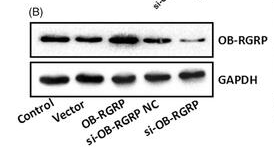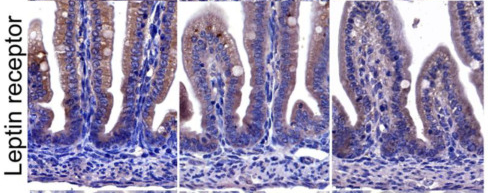产品描述
*The optimal dilutions should be determined by the end user.
*Tips:
WB: 适用于变性蛋白样本的免疫印迹检测. IHC: 适用于组织样本的石蜡(IHC-p)或冰冻(IHC-f)切片样本的免疫组化/荧光检测. IF/ICC: 适用于细胞样本的荧光检测. ELISA(peptide): 适用于抗原肽的ELISA检测.
引用格式: Affinity Biosciences Cat# DF7139, RRID:AB_2839093.
展开/折叠
CD 295; CD295; CD295 antigen; Db; Fa; HuB219; LEP R; LEP-R; LEPR; LEPR_HUMAN; LEPRD; Leptin receptor; Leptin receptor fatty; Leptin receptor gene related protein; Leptin receptor precursor; Leptin receptor precursor; OB R gene related protein; OB receptor; OB-R; OB-RGRP; obl; Obr;
抗原和靶标
Isoform A is expressed in fetal liver and in hematopoietic tissues and choroid plexus. In adults highest expression in heart, liver, small intestine, prostate and ovary. Low level in lung and kidney. Isoform B is highly expressed in hypothalamus, but also in skeletal muscle. Detected in fundic and antral epithelial cells of the gastric mucosa (PubMed:19159218). Isoform B and isoform A are expressed by NK cells (at protein level) (PubMed:12504075).
- P48357 LEPR_HUMAN:
- Protein BLAST With
- NCBI/
- ExPASy/
- Uniprot
MICQKFCVVLLHWEFIYVITAFNLSYPITPWRFKLSCMPPNSTYDYFLLPAGLSKNTSNSNGHYETAVEPKFNSSGTHFSNLSKTTFHCCFRSEQDRNCSLCADNIEGKTFVSTVNSLVFQQIDANWNIQCWLKGDLKLFICYVESLFKNLFRNYNYKVHLLYVLPEVLEDSPLVPQKGSFQMVHCNCSVHECCECLVPVPTAKLNDTLLMCLKITSGGVIFQSPLMSVQPINMVKPDPPLGLHMEITDDGNLKISWSSPPLVPFPLQYQVKYSENSTTVIREADKIVSATSLLVDSILPGSSYEVQVRGKRLDGPGIWSDWSTPRVFTTQDVIYFPPKILTSVGSNVSFHCIYKKENKIVPSKEIVWWMNLAEKIPQSQYDVVSDHVSKVTFFNLNETKPRGKFTYDAVYCCNEHECHHRYAELYVIDVNINISCETDGYLTKMTCRWSTSTIQSLAESTLQLRYHRSSLYCSDIPSIHPISEPKDCYLQSDGFYECIFQPIFLLSGYTMWIRINHSLGSLDSPPTCVLPDSVVKPLPPSSVKAEITINIGLLKISWEKPVFPENNLQFQIRYGLSGKEVQWKMYEVYDAKSKSVSLPVPDLCAVYAVQVRCKRLDGLGYWSNWSNPAYTVVMDIKVPMRGPEFWRIINGDTMKKEKNVTLLWKPLMKNDSLCSVQRYVINHHTSCNGTWSEDVGNHTKFTFLWTEQAHTVTVLAINSIGASVANFNLTFSWPMSKVNIVQSLSAYPLNSSCVIVSWILSPSDYKLMYFIIEWKNLNEDGEIKWLRISSSVKKYYIHDHFIPIEKYQFSLYPIFMEGVGKPKIINSFTQDDIEKHQSDAGLYVIVPVIISSSILLLGTLLISHQRMKKLFWEDVPNPKNCSWAQGLNFQKPETFEHLFIKHTASVTCGPLLLEPETISEDISVDTSWKNKDEMMPTTVVSLLSTTDLEKGSVCISDQFNSVNFSEAEGTEVTYEDESQRQPFVKYATLISNSKPSETGEEQGLINSSVTKCFSSKNSPLKDSFSNSSWEIEAQAFFILSDQHPNIISPHLTFSEGLDELLKLEGNFPEENNDKKSIYYLGVTSIKKRESGVLLTDKSRVSCPFPAPCLFTDIRVLQDSCSHFVENNINLGTSSKKTFASYMPQFQTCSTQTHKIMENKMCDLTV
种属预测
score>80的预测可信度较高,可尝试用于WB检测。*预测模型主要基于免疫原序列比对,结果仅作参考,不作为质保凭据。
High(score>80) Medium(80>score>50) Low(score<50) No confidence
研究背景
Receptor for hormone LEP/leptin (Probable). On ligand binding, mediates LEP central and peripheral effects through the activation of different signaling pathways such as JAK2/STAT3 and MAPK cascade/FOS. In the hypothalamus, LEP acts as an appetite-regulating factor that induces a decrease in food intake and an increase in energy consumption by inducing anorexinogenic factors and suppressing orexigenic neuropeptides, also regulates bone mass and secretion of hypothalamo-pituitary-adrenal hormones (By similarity). In the periphery, increases basal metabolism, influences reproductive function, regulates pancreatic beta-cell function and insulin secretion, is pro-angiogenic and affects innate and adaptive immunity. Control of energy homeostasis and melanocortin production (stimulation of POMC and full repression of AgRP transcription) is mediated by STAT3 signaling, whereas distinct signals regulate NPY and the control of fertility, growth and glucose homeostasis. Involved in the regulation of counter-regulatory response to hypoglycemia by inhibiting neurons of the parabrachial nucleus. Has a specific effect on T lymphocyte responses, differentially regulating the proliferation of naive and memory T -ells. Leptin increases Th1 and suppresses Th2 cytokine production (By similarity).
May transport LEP across the blood-brain barrier. Binds LEP and mediates LEP endocytosis. Does not induce phosphorylation of and activate STAT3.
Antagonizes Isoform A and isoform B-mediated LEP binding and endocytosis.
On ligand binding, phosphorylated on two conserved C-terminal tyrosine residues (isoform B only) by JAK2. Tyr-986 is required for complete binding and activation of PTPN11, ERK/FOS activation,for interaction with SOCS3 and SOCS3 mediated inhibition of leptin signaling. Phosphorylation on Tyr-1141 is required for STAT3 binding/activation. Phosphorylation of Tyr-1079 has a more accessory role.
Cell membrane>Single-pass type I membrane protein. Basolateral cell membrane.
Secreted.
Isoform A is expressed in fetal liver and in hematopoietic tissues and choroid plexus. In adults highest expression in heart, liver, small intestine, prostate and ovary. Low level in lung and kidney. Isoform B is highly expressed in hypothalamus, but also in skeletal muscle. Detected in fundic and antral epithelial cells of the gastric mucosa. Isoform B and isoform A are expressed by NK cells (at protein level).
Present as a mixture of monomers and dimers (Probable). The phosphorylated receptor binds a number of SH2 domain-containing proteins such as JAK2, STAT3, PTPN11, and SOCS3 (By similarity). Interaction with SOCS3 inhibits JAK/STAT signaling and MAPK cascade (By similarity).
The cytoplasmic domain may be essential for intracellular signal transduction by activation of JAK tyrosine kinase and STATs.
The WSXWS motif appears to be necessary for proper protein folding and thereby efficient intracellular transport and cell-surface receptor binding.
The box 1 motif is required for JAK interaction and/or activation.
Belongs to the type I cytokine receptor family. Type 2 subfamily.
研究领域
· Environmental Information Processing > Signaling molecules and interaction > Cytokine-cytokine receptor interaction. (View pathway)
· Environmental Information Processing > Signaling molecules and interaction > Neuroactive ligand-receptor interaction.
· Environmental Information Processing > Signal transduction > AMPK signaling pathway. (View pathway)
· Environmental Information Processing > Signal transduction > Jak-STAT signaling pathway. (View pathway)
· Human Diseases > Endocrine and metabolic diseases > Non-alcoholic fatty liver disease (NAFLD).
· Organismal Systems > Endocrine system > Adipocytokine signaling pathway.
文献引用
Application: WB Species: Rat Sample:
Application: WB Species: Rat Sample:
Application: WB Species: Mouse Sample: hypothalamus
Application: IHC Species: Rat Sample:
Application: WB Species: Rat Sample: TSPCs
Application: IHC Species: Rat Sample:
限制条款
产品的规格、报价、验证数据请以官网为准,官网链接:www.affbiotech.com | www.affbiotech.cn(简体中文)| www.affbiotech.jp(日本語)产品的数据信息为Affinity所有,未经授权不得收集Affinity官网数据或资料用于商业用途,对抄袭产品数据的行为我们将保留诉诸法律的权利。
产品相关数据会因产品批次、产品检测情况随时调整,如您已订购该产品,请以订购时随货说明书为准,否则请以官网内容为准,官网内容有改动时恕不另行通知。
Affinity保证所销售产品均经过严格质量检测。如您购买的商品在规定时间内出现问题需要售后时,请您在Affinity官方渠道提交售后申请。产品仅供科学研究使用。不用于诊断和治疗。
产品未经授权不得转售。
Affinity Biosciences将不会对在使用我们的产品时可能发生的专利侵权或其他侵权行为负责。Affinity Biosciences, Affinity Biosciences标志和所有其他商标所有权归Affinity Biosciences LTD.









